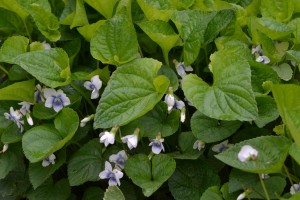 This native violet has taken over one area of my yard almost exclusively, and is spreading into the lawn. I don’t mind, but if you’re a gardener that needs to be in control, I can see issues developing between you and Viola sororia. Woolly blue violet rhizomes can grow quickly, and the many flowers produce many seeds, even in summer from tiny closed (cleistogamous) flowers under the leaves. While you can’t do much about the seeds spreading, you can easily shape or dig out the rhizomes, which are just under the soil surface. The flowers range from purple to blue to almost white, so “blue” violet has to be taken lightly.
This native violet has taken over one area of my yard almost exclusively, and is spreading into the lawn. I don’t mind, but if you’re a gardener that needs to be in control, I can see issues developing between you and Viola sororia. Woolly blue violet rhizomes can grow quickly, and the many flowers produce many seeds, even in summer from tiny closed (cleistogamous) flowers under the leaves. While you can’t do much about the seeds spreading, you can easily shape or dig out the rhizomes, which are just under the soil surface. The flowers range from purple to blue to almost white, so “blue” violet has to be taken lightly.

White form of Viola sororia
This plant can be found from Saskatchewan to Texas and everywhere east from there (except in the Canadian maritimes) , in zones 4 to 8, and likes full to partial shade. The flowers appear in late April and will carry through May and part of June on Cape Cod. The leaves are showy and stay green thoughout the summer. If the conditions are too dry or hot however, the leaves will wither.
Viola sororia is a food plant for many animals, not in the least the caterpillars of several butterfly species – a synonym for this plant, Viola papilionacea, points to this butterfly connection. People also can enjoy this plant: Violets in general are sweet and perfumed in flavor. You can use Viola sororia as follows: Add the tender leaves and flowers to salads. The heart-shaped leaves are edible, and very tasty when cooked like spinach. The flowers are edible as well, and they can add color to salads and desserts.
| Scientific name: | Viola sororia |
| Common name: | woolly blue violet |
| Other name: | common blue violet, sister violet |
| Bloom time: | late spring – early summer |
| Color: | blue, purple, white |
| Light requirements: | full to partial shade |
| Zone: | 4 to 8 |
| Soil: | acidic to neutral |
| Water: | moist |
| Origin: | eastern North America |
Leave a Reply